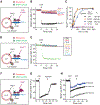T cell costimulatory receptor CD28 is a primary target for PD-1-mediated inhibition
- PMID: 28280247
- PMCID: PMC6286077
- DOI: 10.1126/science.aaf1292
T cell costimulatory receptor CD28 is a primary target for PD-1-mediated inhibition
Abstract
Programmed cell death-1 (PD-1) is a coinhibitory receptor that suppresses T cell activation and is an important cancer immunotherapy target. Upon activation by its ligand PD-L1, PD-1 is thought to suppress signaling through the T cell receptor (TCR). By titrating PD-1 signaling in a biochemical reconstitution system, we demonstrate that the co-receptor CD28 is strongly preferred over the TCR as a target for dephosphorylation by PD-1-recruited Shp2 phosphatase. We also show that CD28, but not the TCR, is preferentially dephosphorylated in response to PD-1 activation by PD-L1 in an intact cell system. These results reveal that PD-1 suppresses T cell function primarily by inactivating CD28 signaling, suggesting that costimulatory pathways play key roles in regulating effector T cell function and responses to anti-PD-L1/PD-1 therapy.
Copyright © 2017, American Association for the Advancement of Science.
Figures




Comment in
-
T cells: Successful checkpoint blockade requires positive co-stimulation.Nat Rev Immunol. 2017 Mar 27;17(4):215. doi: 10.1038/nri.2017.32. Nat Rev Immunol. 2017. PMID: 28345633 No abstract available.
-
Costimulation, a surprising connection for immunotherapy.Science. 2017 Mar 31;355(6332):1373-1374. doi: 10.1126/science.aan1467. Science. 2017. PMID: 28360282 No abstract available.
-
Two Strings in One Bow: PD-1 Negatively Regulates via Co-receptor CD28 on T Cells.Immunity. 2017 Apr 18;46(4):529-531. doi: 10.1016/j.immuni.2017.04.003. Immunity. 2017. PMID: 28423334
References
Publication types
MeSH terms
Substances
Grants and funding
LinkOut - more resources
Full Text Sources
Other Literature Sources
Research Materials

